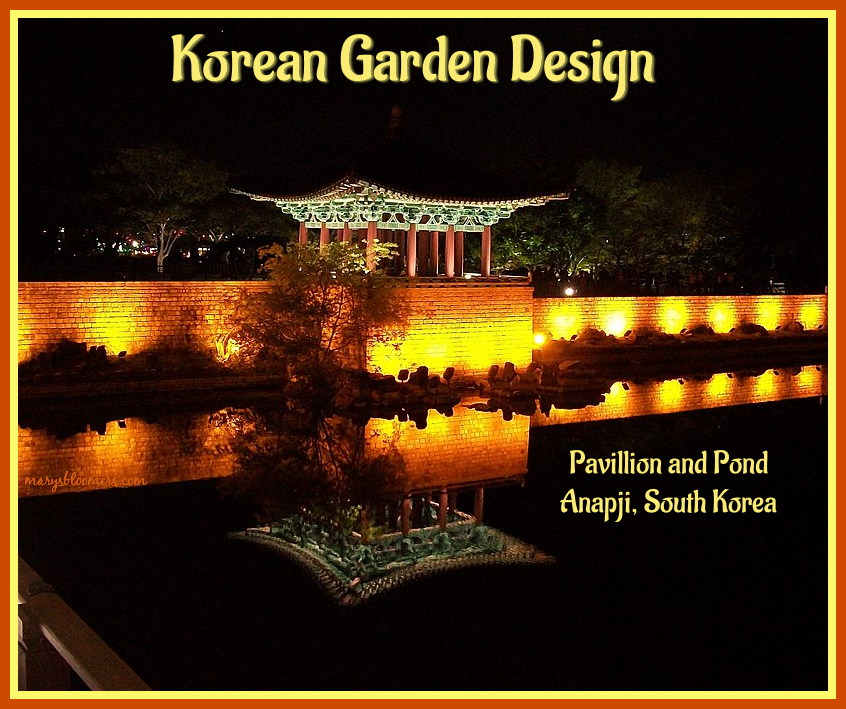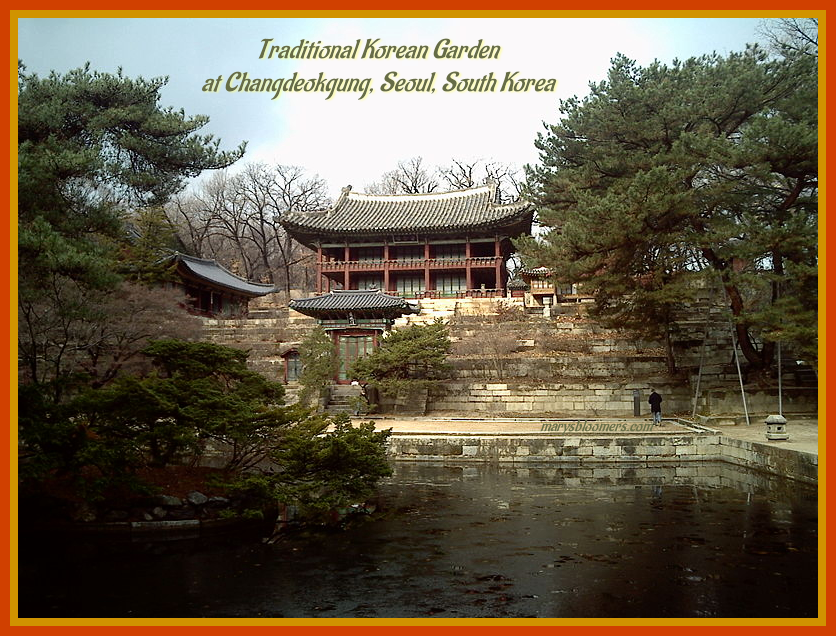|
Anapji, shown in photo
above, is an artificial pond in Gyeongju National Park, South
Korea. It was part of the palace complex of ancient Silla.The pond is an oval
shape. Anapji and the surrounding
garden were designed in a microcosmic style, in order to symbolize the dwellings
of Taoist fairies. The entire area was arranged to create the
effect of a landscape painting. |
|
If you're able to get a pavillion-type structure to place in your garden, i am truly envious. If not, there are a few larger garden sculptures in the pavillion style, that can be the focal point of a Korean Garden landscape, or used in centers of Korean design garden beds or pond. Scholars from the Korean aristocracy sat in their pavilions constructed in either a cultivated garden, or in a natural area with its own view of the mountains or landscape. These served as places of relaxation and enjoyment. Playing chess, painting, resting and other leisurely activities were also pursued in these pavilions, because of the exceptional view and surrounding beauty. The garden may also often have small waterfalls, because water is an important element to any garden for practical reasons, such as plant-watering and cooling the temperature. It was also important, because it prevented the wooden buildings from burning down. In the garden, a murky green color is prized, unlike the Western love of blue water. Clear water is generally found in streams and natural water sources rather than ponds, which are dug out in a convenient spot. Sometimes the water looks black if the inside of the pond is walled with stone blocks. Lotuses are usually the most common thing to plant in a pond, but there are many unusual options other than lotuses. Style, Symbolism and Plantings Korean gardens are structured to live in harmony with pre-existing landscapes. Sites are chosen in favor of the energy flow called pungsu, geomancy which affects all aspects of life including health, wealth, and happiness. Unlike gardening styles of the west, the construction of a Korean garden must be done with as little disruption to the pre-existing site as possible, and can even lend from the surrounding view, such as mountains on the horizon, into its own appearance. The gardens can be found enclosed within walls of stone or brick or can blend seamlessly into its surroundings without a barrier. Buildings and pavilions in the gardens are minimal in number and unobtrusive to the thriving natural landscape. Stylized flowers and blossoms that hold great symbolism, such as the Sacred Lotus and plum blossoms, are painted onto Buddhist temples, royal tombs, and palace pavilions in bright yet harmonious colors. Traditional spiritual and philosophical symbolism can be found throughout Korean gardens; Shamanistic, Animist, Buddhist, Daoist, and Confucian influences along with homage to the Dangun Creation story are often simultaneously represented. From the clear symbols such as stylized decorations painted on pavilions and buildings, to the use of colors and the number and types of trees, rocks, ponds, and plants, all Korean gardens hold a significance of beauty aesthetically, culturally, and spiritually. Examples of Traditional Tree Types and their Meanings: Persimmon: The Persimmon tree symbolizes transformation. Jill Mathews, author of Korean Gardens, writes, “… their fruit starts off hard, green, and extremely bitter but ripens to a bright orange and becomes very soft and sweet. Korean Red Pine: Symbolizes loyalty, constancy, and righteousness. The bark resembles the shell of the tortoise, which symbolizes longevity. Often used near Confucian scholarly buildings and pavilions. Called sonamu, meaning supreme tree. Bamboo: Simplicity, integrity, flexibility. Its uprightness symbolizes strength while its hollow stem equates to open-mindedness. Crepe Myrtle: Baerong
Namu
meaning “Tree with flowers lasting more than 100 days”, symbolize
integrity and loyalty of Confucian scholars and can be found in
Confucian academy gardens. Peonies: Known as the Queen of Flowers, both the tree peony and the herbaceous peony symbolize royalty, riches, honor, female beauty, and love. Lotus:
The lotus is recognizable as a sacred symbol in Buddhism and can be
found in ponds of both Buddhist temples and Confucian academies,
symbolizing purity, transformation, and enlightenment. Ponds: Ponds symbolize tranquility and stillness; inviting deep contemplation from visitors. Their bridges can symbolize moving from lower thought processes to more sacred thoughts, or the movement from life on Earth into the tranquil afterlife. The Daoist and Confucian belief that heaven is round and the Earth is square is often reflected in the appearance of ponds and their island; the pond being square in shape and the island being round. Few Korean gardens are considered complete without at least one pond. I am just learning traditional Korean cuisine, so my garden would need to include the Korean vegetables and herbs. I don't sow seeds, so finding cuttings with roots, or a small seedling, would be the way it goes, except for lettuces, which are very easy to grow from seed. The easier ones would
be: Garlic chives - Same ease in growing as scallions. A pretty perennial that looks like a thick grass. And yes, it smells and tastes like garlic and chives. I prefer these to using just the chives recommended in many Korean dishes. The Italian half of me believes that the more garlic, the better. Best of both worlds in garlic chives. The flowers have a light chive taste, and it tastes great mixed into your salad. Trim the young, top of the leaves for the best taste, and less woodiness than the older bottom parts. Red Lettuce - They grow well in containers and look pretty in clay pots. Korean baby squash - different from zucchini – they are more tender, juicier and sweeter. Korean Chilis - Pennsylvania has a short summer, so growing any pepper variety to maturity is a challenge for me. Timing is everything. In the U.S, good substitute varieties for all Korean Chilis would be Annaheim, jalapenos, or Serrano Peppers Chrysanthemum Greens (not the flower garden type) Korean Cabbage - It's the small variety that open up like a flower, not a head.
In the long tradition of gardens in Korea, adding man-made elements to the purest of spaces is considered a violation and something to be approached with utmost care and reservation. The essential idea behind the Korean art of garden building is to make it look more natural than nature itself. In many cases, what appears to be the result of very conscious efforts. Korean gardens are characterized by a submission to nature in an attempt to attain beauty and function. Korea has a long history of gardens. The oldest records date to Three Kingdoms period (57B.C.-A.D.668) when architecture showed notable development. An important early history of the Korean nation, Samguk sagi(History of the Three Kingdoms) provides numerous pieces of evidence of royal palace gardens. In prehistoric times, Koreans worshipped nature, the sun, stars, water, rocks, stones, and trees. They especially believed that rocks had more power than water and other things in nature. Also, they have believed that rocks engendered God's good-will. Therefore, the arrangement of rocks is considered as one of the "essential" elements in designing the traditional Korean garden. Koreans have recently rediscovered their stone garden tradition in the stacked stone altars that express the ancient concept of a round heaven and square earth. Also Susok or "rock arrangement," gardens are commonly found. In recent years, in fact, there has been a revival of interest in rock arrangements in gardens. In general, Korean Susok (rock arrangement) garden culture can be described according to its stages of development. Even during the primitive agricultural period, stones were an essential element in building gardens. Then, rock arrangements for shamanic rituals were built in the shape of shrines or heavenly altars. Korean gardens simulate the natural landscape with hills, streams and fields. They are usually small in scale, but have an ideal harmony of nature and man. The prinicipal idea is to blend the structures into nature with the least possiible disturbance of the environment, because, in Korean mind, nature is already a perfect and an absolute entity that regenerates and sustains life. sources: |
|
Content, graphics and design ©2020 eyecandee.com This site uses Watermarkly Software
|


